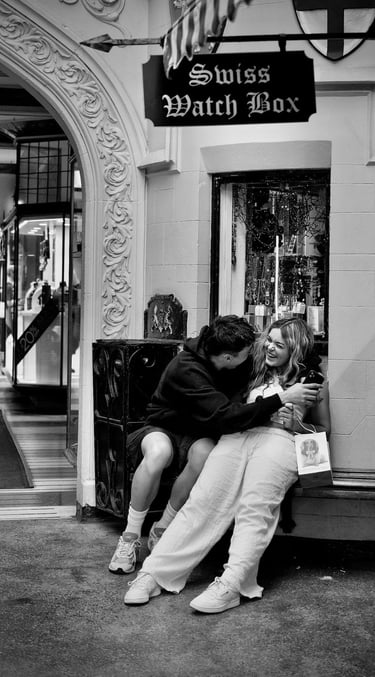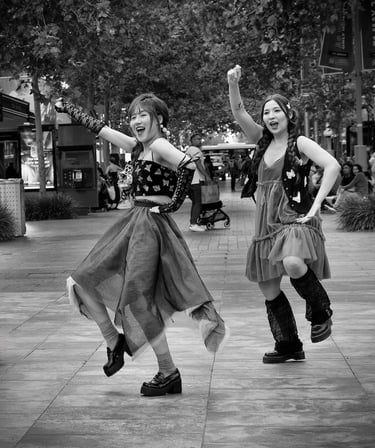Capturing Emotion in Black and White Street Photography: The Power of Monochrome Imagery
Capturing the Heartbeat of the Streets: Emotion in Monochrome Imagery
In the rich, monochromatic world of street photography, emotion is the unspoken language that communicates directly to the soul, far beyond words. As members of a community that immerses itself in the art of capturing life’s fleeting moments, we understand that emotion is not just an accessory in black and white street photography—it is the very heartbeat that gives our images life. Emotion breathes a soul into every photograph, transforming what might otherwise be a simple snapshot into a powerful, evocative narrative.
The Power of Black and White Photography: Stripping Down to Essentials
Black and white photography has a unique ability to strip a scene down to its most essential elements. In removing the distractions of colour, the photographer is free to focus on the raw, emotional core of the image. The stark contrasts between light and dark, the absence of vibrant hues, direct the viewer’s eye to the subtleties that often go unnoticed—the tenderness in the curve of a smile, the quiet despair in a downward glance, the tension in a furrowed brow. In monochrome, human expression is amplified, inviting the viewer to engage with the image on a deeper, more emotional level.
Emotion Through Light and Shadow
In street photography, emotion is not confined to the expressions on people’s faces; it flows through every element of the scene. Light and shadow are more than just visual contrasts—they are emotional forces. The way light falls softly across a subject can convey warmth or hope, while deep shadows can evoke mystery, isolation, or tension. A well-composed black and white image can tell a story entirely through its use of light and dark, leading the viewer through a range of emotions without the need for a single word.
The urban landscape itself becomes a canvas for these emotional stories. Cracked pavement, rain-slicked streets, and graffiti-covered walls all add texture and depth to the narrative, each contributing to the mood of the photograph. These elements, often overlooked in the hustle of daily life, take on new meaning in the absence of colour, helping to frame the emotions of the subjects they surround.




Unveiling the Heart of Street Photography: How Black and White Imagery Enhances Emotional Impact
Capturing Universal Human Emotions
Our group champions the pursuit of these emotional stories found in the streets. We encourage photographers to seek out the raw, unguarded moments that reveal the essence of the human spirit. These moments might be fleeting—a glance between strangers, a child’s burst of laughter, an old man’s tired eyes as he waits for a bus—but they hold within them a deep emotional truth. They are the moments that connect us as humans, transcending cultural or linguistic barriers, touching on universal experiences of joy, sorrow, loneliness, camaraderie, hope, and despair.
In these moments, black and white photography becomes more than a stylistic choice; it becomes a way of seeing and feeling. The lack of colour forces both the photographer and the viewer to look deeper into the scene, to feel the emotions beneath the surface. This is where true street photography lies—not in the technical perfection of an image, but in the emotional resonance it holds.
The Photographer as Observer and Storyteller
Great black and white street photography demands more than just technical skill; it requires empathy, patience, and a keen sense of observation. As photographers, we are both silent observers and compassionate storytellers. We stand at the edges of the bustling world, our cameras ready, waiting for those brief moments when emotion slips through the cracks of everyday life. It’s about more than simply snapping a picture—it’s about uncovering the emotional truth behind a moment and capturing it in a way that feels intimate and real.
This process demands sensitivity. A photographer must anticipate emotion, sometimes before it even unfolds. This is not always easy, but with practice, it becomes instinctual. The key is to be present—not just physically, but emotionally. To truly capture the heart of a scene, a photographer must immerse themselves in the environment, paying attention not only to the visual but to the emotional cues around them.
The Art of Evoking Emotion in the Viewer
What makes black and white street photography so powerful is its ability to evoke a response in the viewer. A truly great photograph doesn’t just document a moment—it elicits a feeling, inviting the viewer into the scene, asking them to participate emotionally. Whether it’s a moment of joy or sadness, tension or relief, the emotion in the photograph resonates with the viewer, drawing them in and allowing them to experience the scene on a personal level.
These photographs are open to interpretation; they invite questions rather than providing answers. What is the story behind that glance? What thoughts are hidden behind that expression? Each viewer brings their own experiences to the image, allowing them to connect with it in a way that is both universal and deeply personal. This is the magic of black and white photography—it transcends the specific details of the scene, reaching instead for the underlying emotions that unite us all.
Embracing the Emotional Essence of Monochrome Photography
Emotion is not just an element of black and white street photography; it is its essence. It’s what makes a photograph memorable, what gives it staying power in the mind of the viewer. In a world awash with millions of digital images, it is the emotionally charged black and white photographs that linger, that stay with us long after we’ve turned away from the screen. These photographs reflect the complexities of life—the beauty, the pain, the quiet moments of introspection—and they do so in a way that feels raw and honest.
As we continue to walk the streets with our cameras in hand, let us remember to look beyond the surface. Let us search for those moments when emotion rises to the forefront, when the human experience is laid bare in all its complexity. In doing so, we capture not just images, but stories—stories that speak to the heart of what it means to be human. And in those stories, we find the true power of monochrome imagery.
Copyright © 2025 Peter Pickering. All Rights Reserved. All Wrongs Reversed.
🌐 peterpickering.com | 🎺 sessionsonthegreen.com | 💜 isaacbcole.com | ▶️ YouTube Channel | 🌿 life.peterpickering.com


